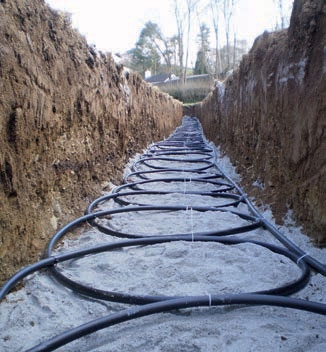These appliances extract warmth from the air or ground and convert it to usable, higher temperature heat that can be used for space heating and hot water. Both units operate in a similar way to a fridge – but in reverse. Powered by electricity, heat pumps deliver a lower output temperature than conventional boilers. For that reason, they’re best suited to low flow emitting systems such as underfloor heating or oversized radiators.
Ground source heat pumps (GSHPs) extract warmth from the earth via collector units laid underground. A slinky arrangement comprising loops of buried piping is the most common setup, connected to a heat pump unit that is positioned inside the house. A mixture of water and antifreeze is circulated through the conduits, picking up warmth as it goes. This is then concentrated in the heat exchanger and conveyed to your home’s central heating system. “By using freely available heat energy from the ground, the electrically powered heat pump delivers three times more energy than it consumes, significantly reducing running costs,” says Stephanie Gregory from Kensa Heat Pumps. “For every 1kWh of energy your appliance uses to power itself, you’ll typically get 3kWh of heat.”
Air source heat pumps (ASHPs), on the other hand, repurpose energy from the external air, converting it into useful warmth. A fan-powered unit is installed outside your dwelling. It blows the air over a collecting coil that’s filled with a special solution that absorbs heat. This is condensed by an electricity-powered compressor before being transferred to a heat exchanger so it can be used to warm the water in your central heating system.
Because the temperature of the earth remains at a more consistent heat all year round (8°C-12°C), GSHPs tend to offer a more predictable performance than their air source cousins. However, the latter are more affordable and less disruptive to install. Even better, the government’s Renewable Heat Incentive (RHI) scheme offers quarterly payments for installations of both types – more on page 87. “To be eligible, the professional who fits the system must be MCS accredited,” says Stephanie.

This slinky setup shows the installation of a Kensa ground source heat pump. Above: Simon Baker installed an ASHP to power his home’s central heating. The unit is situated discreetly to the side of the property